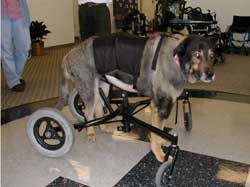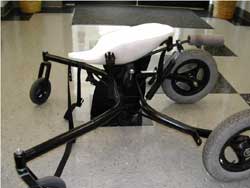Evaluation Of A Service Delivery Model On A Canine Subject
ABSTRACT:
The service delivery model used by most DME dealers across the nation is considered quite effective. This paper reports on a test of the universality of that service delivery model on a non human subject. Animal rehab has had little or no representation in the nation's network of rehab providers. After being approached by the owners of a disabled canine, it was decided that evaluating this canine client using our current service delivery model would be an excellent test of the model itself.
KEY WORDS:
Canine; Dog; Service delivery
BACKGROUND:
Whitmyer Biomechanix' clinical division was approached by the owners/caregivers of a disabled shepherd mix dog to provide a mobility aid to allow the dog some form of mobility. An intake interview was conducted and it was determined the no local source existed for rehab equipment for dogs and that local veterinarians had no referral sources either. An appointment was made to do a full evaluation of the dog's physical condition and mobility needs. While none of our staff has any experience working with animals in a rehab capacity it was felt that being a rehab provider with extensive custom fabrication capacity put us in the position as the most likely company to be able to help this family. With no past experience in animal rehab it was decided that it would be best to utilize the same service delivery model that we use with our human clients. Our standard initial contact and intake interview procedures had already been used without modification for this non human client.
APPROACH:
When initial contact was made on the evaluation date, introductions where made and it was discovered that the dog was named "Scout" and that he was very well mannered. He was transferred to a fitting and evaluation room where the information gathering phase of the evaluation could begin.
Scout's caregivers were better prepared than most of our clients, providing Scout's medical records, including his current anatomical measurements and a description of his physical condition from his treating veterinarian. Scout's primary diagnosis was partial paralysis of the rear extremities secondary to a spinal infection. He also had a history of a hip replacement surgery approximately 6 years post and arthritis causing pain in his front shoulders. A thorough mat evaluation was conducted to determine his range of motion and identify any spinal deformity. A fixed deformity extending from the third lumbar vertebrae to the pelvis was identified with no apparent tenderness (we would consider it a fixed lumbar lordosis and posterior pelvic tilt if he were human). It was interesting to note that it was no more difficult to perceive the comfort level of this dog than it is for any of our non verbal human clients. It was also noted by the caregivers that he was able to walk independently when wading up to his neck in the local lake but that gravity was too much for him to overcome on land.
 |
|---|
After the physical evaluation was completed we moved to the goal setting phase to determine if his physical limitations would allow us to meet the family's goals. An interview of the caregivers revealed that their goal was to give scout some form of independent mobility in an upright posture. It was felt that the standing position would be important to allow scout to feel more equal to the other animals that passed by. The treating veterinarian thought that if a sternal support could be made to support him from below that he would have the mobility that he needed much like being in the water. It was also noted that he would need some support for his pelvis as well to reduce the weight that his hind legs had to bear and to keep him centered in the device.
It was determined that we should be able to fabricate a custom solution for this client without major difficulty. Payment options were discussed and determined to be private pay for all materials and labor and it was agreed that I would use any salvaged or donated parts available to help keep the cost down.
 |
|---|
It was felt that since we were going to try to support the chest sternally, that we needed to spread the weight over as much area as possible and would need it to be an intimate fit. We decided to make a cast of the dog's chest so that we could custom form the support out of plastic using the vacuum forming process. We chose plaster as our casting media and covered the area to be cast with plastic sheet to protect his fur. We cast him supine and the caregivers and our staff comforted him by rubbing his belly to keep him calm. He was actually much better behaved than many of our molded clients. We then took the cast and poured a foam positive in it to use in the vacuum forming process. We then vacuum formed two ¼ inch layers of Aliplast foam and then the 3/8 inch polyethylene shell on top of that. We had a donated Prairie Seating Luv base that we decided to use as a foundation because of its pedestal design. We modified this base by lowering the pedestal height and widening the front end for additional paw clearance and removing the rear cross support bar. The base's tilt mechanism was retained to mount the pelvic support bar to and also allow the height of scout's pelvis to be adjusted while in the system. The chest support shell was mounted to the pedestal post and adjusted to the correct chest to floor height. Finally we fabricated a custom harness to go over scouts back and hold him in the system as well as allow his collar to be strapped to the system to give him orientation front to rear.
RESULTS:
On the day of the final delivery we made final adjustments and did caregiver training. Getting him into the system turned out to be a full two person lift but manageable for the caregivers. Scout's first attempts to walk were tentative but very successful and had his tail wagging for what the caregivers said was the first time in ages. The system was sent home with the family with instructions to try the system for a week or so and let us know if anything needed to be changed.
During following visits we added a stroller handle to help on hills and to give directional guidance on narrow sidewalks. Scouts rear paws had to be wrapped when walking as he tended to drag his toes part of the time.
Overall the service delivery model that we use on a daily basis worked remarkably well for this canine subject and should work for other canines as well. It also showed that Rehab technology suppliers may well be the best equipped to provide services for animals as no other source for help is as widely available.
